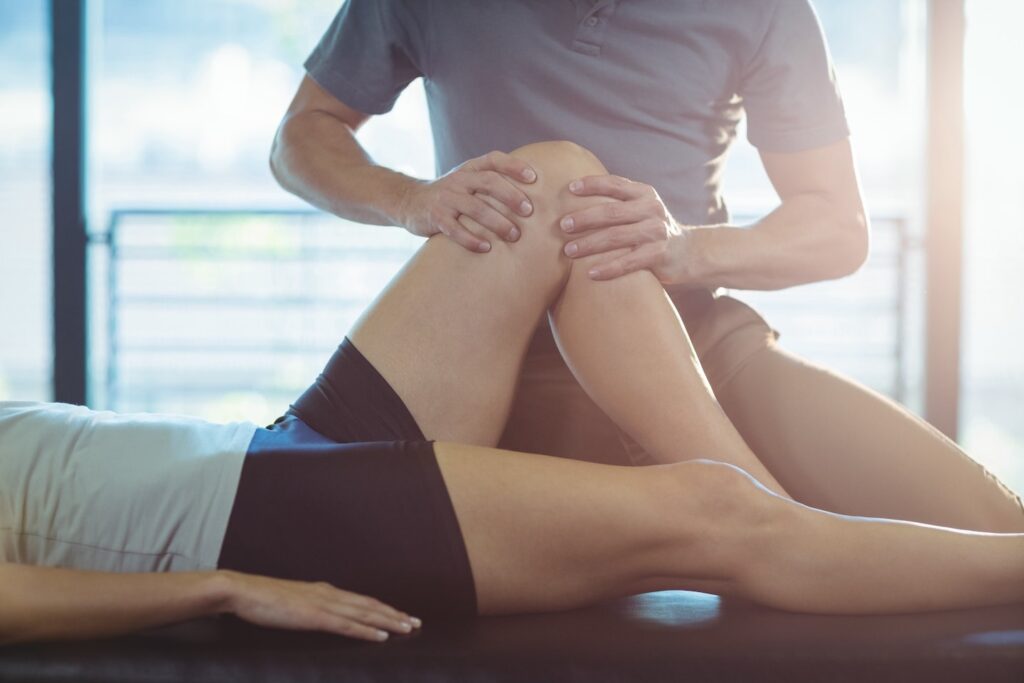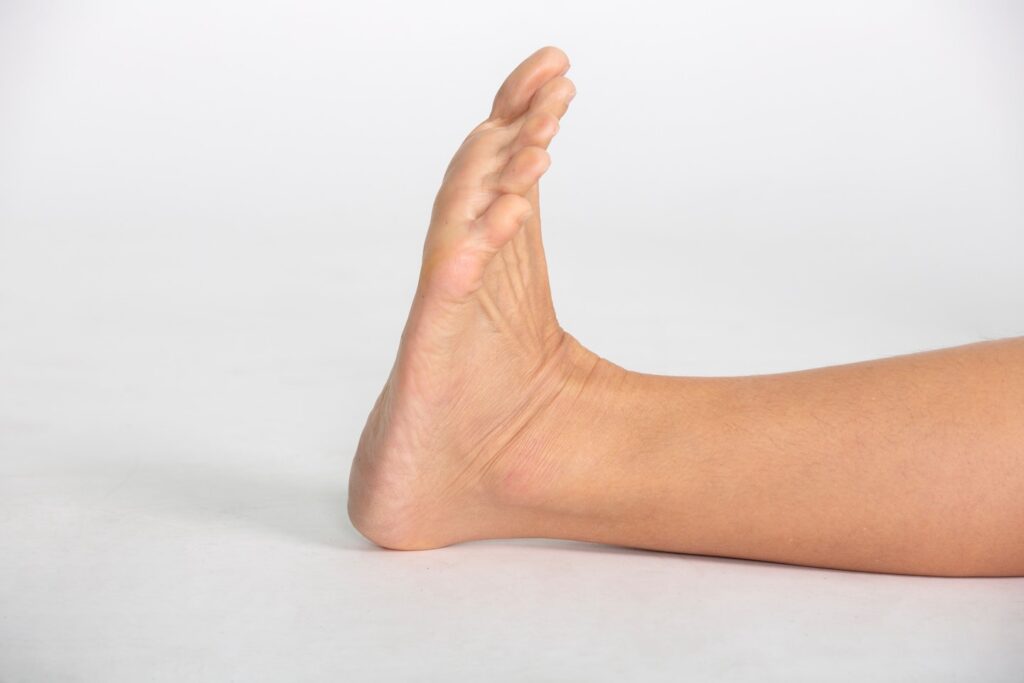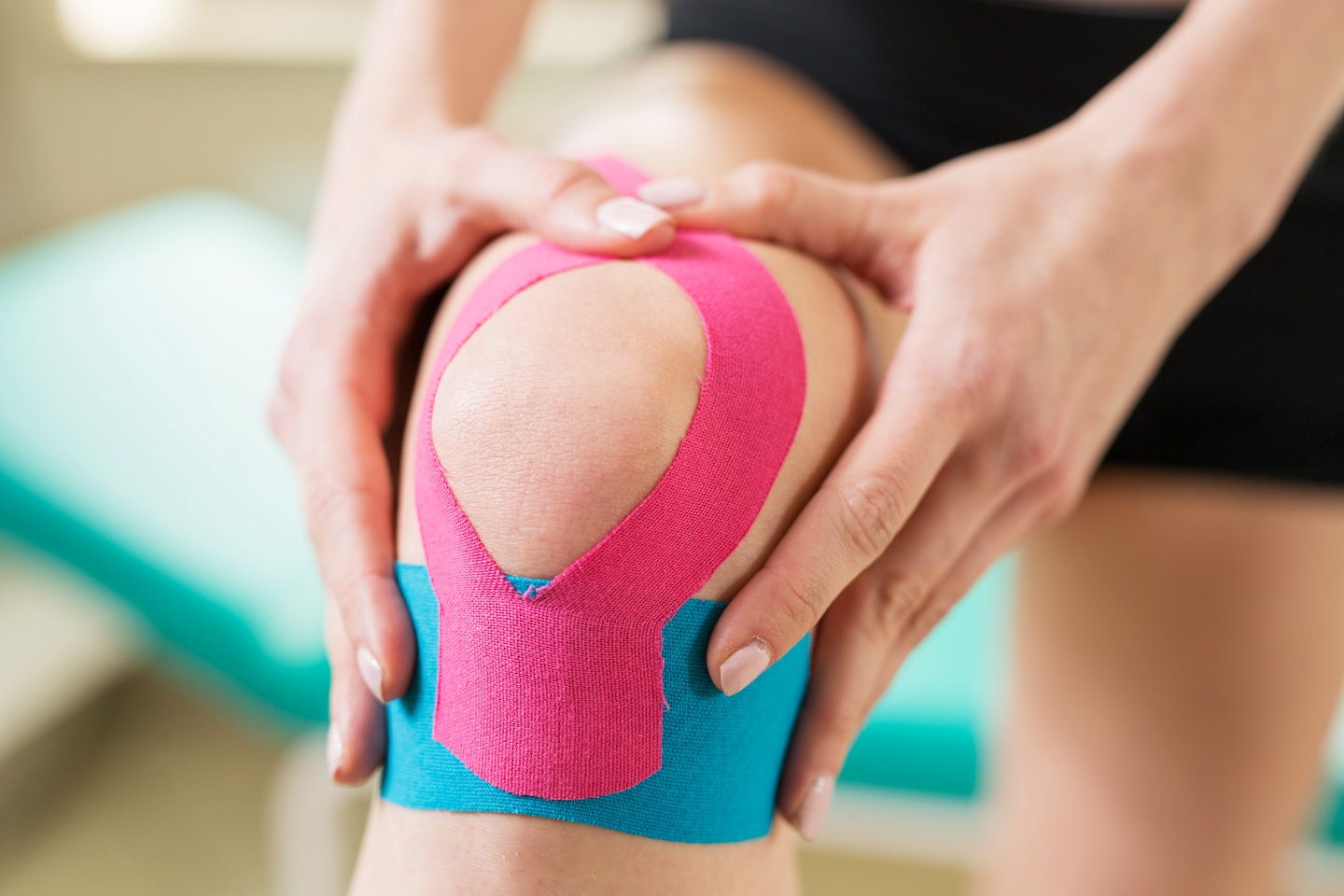Recovering from knee arthroplasty means dedicating time to the right physical therapy exercises. This article highlights the top physical therapy exercises after knee arthroplasty, covering early, intermediate, and advanced stages. These exercises will help you reduce pain, improve mobility, and strengthen your knee.
Key Takeaways
- Early-stage rehabilitation exercises like ankle pumps and quadriceps sets are critical immediately post-surgery to improve blood flow, prevent complications, and strengthen knee muscles.
- Intermediate and advanced rehabilitation exercises, such as heel slides, straight leg raises, and stair climbing, are essential for increasing the range of motion, and muscle strength, and preparing the knee for everyday activities.
- Long-term maintenance, including resistance and cardiovascular exercises, is crucial to sustaining recovery and enhancing overall knee strength and flexibility, ensuring an active life post-knee arthroplasty.
The Road to Recovery Post-Knee Arthroplasty with Physical Therapy

The road to recovery post-knee arthroplasty is paved with targeted movements and exercises. Physical therapy, starting as soon as the surgeon recommends, typically within the first 24-48 hours post-surgery, is not a mere recommendation but a cornerstone for a successful recovery. Doing physical therapy exercises immediately after knee replacement surgery can significantly enhance recovery and alleviate post-operative pain. A physical therapist becomes your ally, introducing you to an exercise program that catalyzes healing, bolsters blood flow, and fortifies the knee joint.
These exercises are not just arbitrary movements; they’re scientifically curated to prevent complications such as blood clots and to promote knee movement and muscle strength. From ankle pumps to quadriceps sets, each activity is designed to lay a strong foundation for the new knee, ensuring that the initial weeks after surgery are marked with progressive, pain-free mobility.
Stepping into the world of recovery post-knee surgery is akin to restarting a paused active life. There’s a symphony of benefits that come with regular exercise after a knee replacement, including:
- Weight management
- Stress relief
- Improved joint strength
- Increased flexibility
- Better balance
It’s like hitting the play button after a commercial break, with the bonus of doing your body a world of good.
Experts agree that staying active is particularly beneficial for those with knee osteoarthritis, especially after knee replacement surgery. Regular exercise, coupled with a gradual return to everyday activities, is the secret sauce for recovering and thriving post-surgery. This blog post is your roadmap to rediscovery, detailing the exercises that will help you reach forward toward a future of unhindered movement and robust health.
Early-Stage Rehabilitation Exercises

The dawn of your recovery process begins with early-stage rehabilitation exercises. Imagine these exercises as the first whispers of movement, gently coaxing your knee back to life. The physical therapist will introduce you to leg-strengthening exercises designed to improve blood flow and prevent the formation of blood clots — your first allies in the battle against immobility. The primary goal during this nascent phase is to improve your range of motion and strengthen the quadriceps, setting the stage for the more challenging exercises to come.
Knee-strengthening exercises are not only about building muscle; they’re about reclaiming independence. These specific exercises will gradually coax your knee into a symphony of movement, each note resonating with your commitment to the recovery process. Some exercises to try include:
- Ankle pumps
- Quadriceps sets
- Straight leg raises
- Hamstring curls
- Calf raises
- Step-ups
- Wall squats
By incorporating these exercises into your routine, you can strengthen your knee and regain your mobility.
Ankle Pumps
Ankle pumps are like the gentle ebb and flow of the tide, rhythmically moving to improve circulation and reduce swelling in the lower extremities. As you contract your calf and shin muscles, imagine the blood flow in your leg strengthening, carrying away the vestiges of surgery-induced stiffness. This simple yet effective exercise can be performed for 2 to 3 minutes, multiple times an hour, paving the way for a faster recovery.
Persist with these ankle pumps until the swelling in your ankle and lower leg has waved its final goodbye. As you move your foot up and down, you’re not just working towards reducing swelling; you’re also fostering a better connection between your brain and your leg, a partnership that’s crucial for the journey ahead.
Quadriceps Sets
Quadriceps sets are the unsung heroes of early knee rehabilitation. They involve a simple contraction of the thigh muscles, a deliberate attempt to straighten the knee without moving it, thus avoiding strain. As you engage these muscles, hold the position for a breath — five to ten seconds of focused effort that ignites the strength within your thigh. This exercise is a silent warrior, working behind the scenes to build a foundation of strength that will support your knee through the exercises to come.
Repeat these quadriceps sets regularly throughout the day, pacing them out to allow your muscles to rest and recover between sets. With each repetition, you’re not only enhancing flexibility but also fortifying the very muscles that will support your knee’s new lease on life.
Intermediate Rehabilitation Exercises
As you wave goodbye to the initial phase of your recovery, intermediate rehabilitation exercises await, ready to challenge you further. It’s like graduating from the shallow end of the pool to deeper waters, where the movements become more dynamic and functional. These exercises are your bridge, spanning the gap between basic mobility and an active lifestyle, reducing stiffness and enhancing the knee’s range of motion.
The focus for the first six weeks post-knee replacement is on this very transition, with exercises that are designed to increase knee movement and strengthen muscles for knee replacement patients. It’s a time when your commitment to a 20–30-minute daily exercise routine will begin to pay dividends in terms of improved flexibility and function.
Heel Slides
Heel slides serve as an essential stepping stone in your journey towards recovery. As you lie on your back, legs extended, and slide your heel towards your buttocks, you’re not just bending your knee — you’re weaving strength into the very fabric of your thigh muscles. This movement is a delicate dance, one that should be performed up to ten times in a session, with care taken not to lift the heel off the bed or allow the knee to roll inward — a dance that improves your range of motion with every careful slide.
With each repetition, you’re not only regaining the suppleness of your knee but also preparing your body for the more strenuous activities that lie ahead. It’s an exercise that demands patience and precision, rewarding you with a knee that bends a little more each day, ready to take on the world.
Straight Leg Raises
Straight leg raises are where the real challenge begins for your surgical leg. Introduced a few weeks after surgery, these exercises call upon you to summon strength from your thigh muscle, lifting your leg into the air and holding it aloft. It’s a test of endurance, with the knee fully straightened and the leg held for 5 to 10 seconds before gently lowering it back down — a testament to your increasing strength.
These raises are pivotal, strengthening the muscles around the knee joint without placing undue stress on it. As you perform each raise, envision your leg growing stronger, more capable, and more resilient — ready to support you as you move forward in your recovery journey.
Advanced Rehabilitation Exercises
As you crest the hill of intermediate exercises, advanced rehabilitation exercises come into view, offering a new challenge to conquer. These exercises are not just about regaining what was lost; they are about enhancing your knee’s strength and endurance to levels perhaps not seen before. They require a balance of caution and courage, as you introduce your knee to more complex movements designed to build upon the progress you’ve already made.
Some advanced rehabilitation exercises to consider include:
- Single-leg squats
- Step-ups with weights
- Lateral lunges
- Bulgarian split squats
- Plyometric exercises such as box jumps and jump squats
Remember to always consult with your healthcare provider or physical therapist before attempting advanced exercises to ensure they are appropriate for your specific condition and stage of recovery.
The exercises in this stage will have you testing the limits of your knee’s flexibility and strength. From prone knee extension stretches to side leg lifts, each movement is a calculated step towards achieving not just recovery, but a stronger and more capable knee.
Standing Knee Bends
Standing knee bends are your opportunity to stretch and strengthen your knee in a standing position. It’s a slow and gentle exercise, one that asks you not to rush but to move with mindful intention. As you bend and straighten your knee, allowing the muscles to flex and extend, you’re not just working on flexibility — you’re helping your knee to rediscover its full range of motion through knee flexion. Additionally, sitting knee flexion exercises can complement this standing routine for a comprehensive approach to knee health.
As you grow more comfortable with the standing knee bends, you can add complexity by lifting your leg backward, engaging your buttocks, and challenging your balance. It’s a progression that builds not just physical strength but also confidence in your knee’s abilities.
Stair Climbing
Stair climbing is a rite of passage in advanced knee rehabilitation. It’s not just an exercise; it’s a symbol of your journey, each step a milestone in your recovery.
Here’s how to do it:
- Initially, you’ll need the support of a handrail.
- Move slowly and deliberately.
- Lead with the non-operated leg on the way up.
- Descend with the operated leg.
With each ascent and descent, you’re not only working on knee strength and endurance but also preparing for the complexities of everyday life. Stair climbing is an exercise that mimics the daily challenges you’ll face, ensuring that when the time comes, your knee will be ready to rise to the occasion.
Functional Mobility Exercises
The ultimate goal of any rehabilitation program is functional mobility — the ability to move through life with ease and confidence. Functional mobility exercises are your gateway to returning to the everyday activities that define your lifestyle. Whether it’s:
- walking to the mailbox
- cycling to the corner store
- climbing stairs
- getting in and out of a car
- bending down to pick something up
These exercises are designed to improve your overall mobility and reintroduce your knee to the movements it was once so familiar with.
From walking short distances to performing resistance exercises, each activity in this phase of your recovery is a step towards regaining the strength and movement your knee needs to support your active life.
Walking
Walking is perhaps the most fundamental of functional mobility exercises. It’s a simple act that carries profound benefits for knee recovery and strengthening. As you walk, you’re not just moving your legs; you’re engaging your entire body in a coordinated effort to improve mobility and strength.
The recommended duration of walking varies, but starting with 20 to 30 minutes daily and progressing to 30 minutes 2 to 3 times daily can significantly aid your recovery. As you walk, focus on proper technique — heel touch first, then foot flatten, and finally toe lift. This approach ensures that you’re not just walking but doing so in a way that maximizes the benefits for your knee.
Cycling on a Stationary Bike
Cycling on a stationary bike is another cornerstone of functional mobility exercises. It allows you to regain muscle strength and knee mobility in a controlled and low-impact way. Initially, you may find it easier to pedal backward before progressing to forward pedaling, as this can be gentler on the knee.
When cycling, adjust the seat height so that your foot can just touch the pedal with the knee almost straight — this position ensures that you’re working your knee through a full range of motion without overextending it. As you cycle, envision the wheels turning as a metaphor for your recovery, each rotation bringing you closer to your goals.
Pain Management During Exercise
As with any exercise program, pain management is a critical component of the recovery process. It’s essential to listen to your body and use techniques like heat or cold therapy and electric stimulation to alleviate pain during exercise. These strategies not only manage discomfort but can also promote tissue healing, allowing you to continue your exercises without unnecessary setbacks.
When dealing with knee pain, low-impact exercises are generally recommended over high-impact ones to avoid stressing the knee. Weightlifting can be an excellent way to build strength and reduce knee pain, but it’s important to choose weights that are appropriate for your size and strength to prevent overburdening your knee.
Icing and Elevation
One of the most effective methods for managing pain after exercising is the combination of icing and elevation. If you experience knee pain or swelling post-exercise, immediately elevate your leg and apply ice wrapped in a towel. By keeping the knee elevated above heart level, you encourage the reduction of fluid build-up and swelling, allowing for faster recovery.
Engage in this cooling ritual for about 20 minutes, but ensure that it’s not directly on the skin to avoid frostbite. Afterward, remove the ice for 20 minutes before repeating the sequence, ideally for a couple of hours. This icing routine, particularly when paired with a compression wrap, can significantly enhance the effectiveness of the therapy, thus reducing swelling and improving circulation post-exercise.
Listening to Your Body
Your body is an excellent communicator, especially when it comes to pain. During knee arthroplasty rehabilitation, it’s crucial to heed these signals to prevent further injury. If certain rehab exercises cause severe pain, it’s a sign to stop and consult with a healthcare professional. Remember, discomfort is expected, but pain is a warning.
It’s also important to take breaks when you encounter pain or stiffness. These pauses are not signs of weakness but of wisdom. They are the moments that allow you to reflect on your progress and adjust as necessary, ensuring that you do not push yourself too far too fast. Listening to your body helps maintain morale and prevents discouragement, an essential part of the recovery process.
Long-Term Maintenance and Progression
Recovery from knee arthroplasty isn’t a sprint; it’s a marathon. Long-term maintenance and progression are about continuing the exercises prescribed by your physical therapist and integrating them into your daily routine. It’s about:
- Pushing forward
- Gradually increasing the intensity and complexity of your workouts
- Making these exercises a regular part of your life to ensure a full recovery
As you embark on this journey, remember that regaining strength is a critical aspect of returning to the activities you enjoy. Experts recommend 20–30 minutes of exercise a day, even after the initial recovery period, to maintain the gains you’ve made. Monitoring your progress can also be incredibly motivating, whether through journals or apps, helping you visualize milestones and adjust your exercises as necessary.
Resistance Exercises
Resistance exercises play an integral role in the long-term strengthening of your knee. Incorporating light ankle weights during knee exercises helps enhance muscle strength and is typically started 4 to 6 weeks after surgery. Gradually increasing the tension on the exercise bike also contributes to a more robust recovery.
These exercises are designed to build strength gradually, supporting your knee as it adapts to the increased demands placed upon it. By continuing these activities, you’re not just maintaining the health of your knee; you’re also preparing your body for the future, ensuring that it can handle whatever life throws your way.
Cardiovascular Exercise
Cardiovascular exercise is not just about getting your heart rate up; it’s about maintaining overall health and supporting the knee during the recovery process. Activities like swimming, water aerobics, and using elliptical machines are excellent options for those with artificial knees, as they provide a good workout without putting undue stress on the joints.
Engaging in these types of exercises can improve circulation and strengthen the muscles around the knee, aiding in a smoother and more efficient recovery. As you make these activities a part of your routine, they will contribute to not just your knee health but your overall well-being, allowing you to enjoy a more active and fulfilling life post-surgery.
Summary
In conclusion, the journey to recovery after knee arthroplasty is a structured path of carefully chosen exercises, each designed to rebuild the knee’s strength and flexibility. From the gentle beginnings of ankle pumps and quadriceps sets to the more demanding heel slides and standing knee bends, each exercise paves the way to a life of mobility and strength. Remember, the key to a successful recovery is consistency, patience, and a willingness to listen to your body.
Your new knee has the potential to unlock a level of activity and freedom you may have thought lost. Embrace the exercises, trust the process, and let each step forward be a testament to your resilience. Here’s to your health, mobility, and the many steps you’ll take in the future — may they lead you to a life of boundless activity and joy.
Frequently Asked Questions
How soon after knee arthroplasty should I start physical therapy?
You should start physical therapy within 24-48 hours after knee arthroplasty, following the recommendation of your surgeon.
What are some early-stage rehabilitation exercises I can do?
You can start your rehabilitation with ankle pumps and quadriceps sets to improve circulation and strengthen thigh muscles without straining the knee. These exercises are excellent for early-stage rehabilitation.
Can I manage post-exercise pain at home?
Yes, you can manage post-exercise pain at home by using techniques like icing and elevation to reduce swelling and pain. It’s important to listen to your body and take breaks if you experience severe pain.
When can I incorporate resistance exercises into my recovery program?
You can incorporate resistance exercises into your recovery program 4 to 6 weeks post-surgery to build strength. It’s important to start with light ankle weights and increased tension on the exercise bike during this time frame.
Are cardiovascular exercises safe after knee arthroplasty?
Yes, low-impact cardiovascular exercises such as swimming, water aerobics, and using elliptical machines are safe and beneficial for maintaining overall health and aiding knee recovery. Incorporating these exercises can promote a quicker rehabilitation process after knee arthroplasty.





 William D. Murrell, MD
William D. Murrell, MD Thomas B. Evely, DO
Thomas B. Evely, DO Clifford Voigt, MD
Clifford Voigt, MD Karthikeyan Chinnakkannu, MD
Karthikeyan Chinnakkannu, MD Max N. Seiter, MD
Max N. Seiter, MD Demetris Delos, MD
Demetris Delos, MD Lauren M. Fabian, MD
Lauren M. Fabian, MD